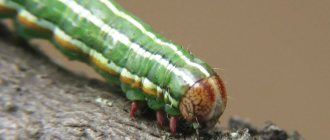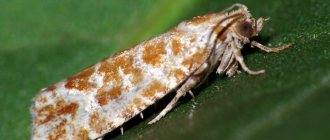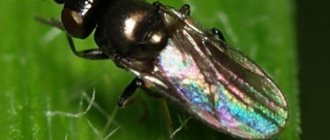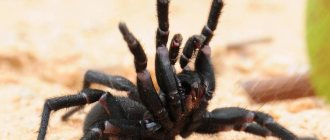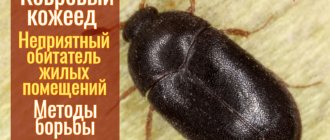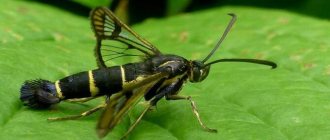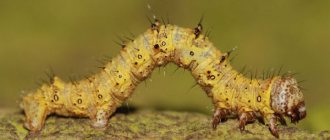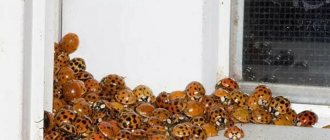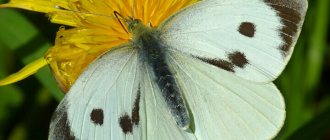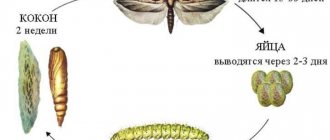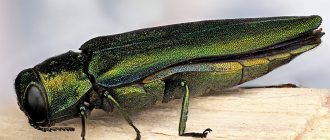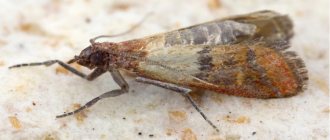Glassworts, or Sesiidae, belong to the Lepidoptera family. Butterflies of this family are representatives of the numerous suborder Proboscis. The identification of these insects into the family of glass butterflies belongs to the French entomologist Jean-Baptiste de Boisduval, who studied these butterflies in 1828.
Today there are 152 genera of Sesiidae Boisduval represented in the world. This is almost 1,384 species, of which 115 species live in Europe, and 50 species or 8 genera inhabit the European part of Russia. Another 8 species are common in the Chuvash Republic.
Of particular importance for the agricultural industry is the study of:
- apple glass, or Synanthedon myopaeformis;
- currant glass, or Synanthedon tipuliformis;
- Raspberry glassweed, or Pennisetia hylaeiformis.
How to get rid of a butterfly?
The difficulty of saving plantings is due to the fact that the blackcurrant glass is a parasite under the protection of the tissues of the plant itself; almost its entire life cycle takes place inside the branches. Therefore, they usually use a whole range of multidirectional measures:
- use of biological products;
- use of pesticides;
- folk remedies and methods of organic farming;
- preventive measures.
Biological protection against pests
Bioactive preparations to combat glassworm are based on the use of toxins from various fungal cultures, which effectively affect the digestive system of insects. At the same time, not only currants, gooseberries, and yoshta require treatment with biological products, but also planting raspberries; During the summer, adults feed on its pollen.
Currant glass has good sensitivity to the following organic-based drugs:
- Fitoverm. An insectoacaricide that has a collateral effect on the kidney mite. Dilute 2 ml in a bucket of water. Working composition consumption is 1.5 liters per bush. The treatment is repeated twice with an interval of 2 weeks;
- Agravertine. Dilute 5 ml per 1.5 liters of water. Spraying is carried out once every 2 weeks;
- Bitoxibacillin. Dilute 35 ml in half a bucket of water. The finished composition is not stored, it is used in one day. Consumption of working product is half a liter per bush. Irrigation is carried out twice, the second time after 7-8 days;
- Lepidocide. Dilute 50 ml in a bucket of water. Spray the plants twice with a break of 1-1.5 weeks.
Use of industrial drugs
The use of biological products alone against pest caterpillars is not enough, so you should know how to deal with glassware on currants using pesticides. Several industrial chemical compounds have proven themselves to be effective:
| Table for preparing solutions for processing currants | ||||
| A drug | Compound | Quantity of drug | Amount of water in liters | How to process |
| Karbofos | Insectoacaricide based on organophosphorus compounds. Toxic to bees, do not treat during flowering. Only freshly prepared solution is used. | 60 g | 8 | For 1 bush use 1.5 liters of working solution. The maximum number of treatments is 2 with an interval of 2 weeks, the last one 30 days before harvest; |
| Trichlorometaphos-3 | Contact drug based on organophosphorus substances. Poses a danger to bees. | 20 g | 10 | Sprayed, like karbofos, before flowering begins. Irrigation of the soil under berry crops contributes to the death of all larvae and pupae on its surface. |
| Fufanon | Organophosphorus insecticide with a broad spectrum of action. Dangerous for bees. | 10 ml | 10 | Spraying should be carried out no more than 2 times, the last one 20 days before the harvest ripens. Working mixture consumption 1.5 l per plant |
| Kemifos | Analogue of Karbofos. | 10 ml | 10 | Apply at the beginning of the growing season, use only freshly prepared mixture. Consumption 1-1.5 liters per plant. |
| Iskra M | Contact insectoacaricide based on malathion with a wide spectrum and short period of action. Low toxic. | 10 ml | 10 | To spray 1 plant, 1-1.5 liters are required |
| Kinmiks | Insecticide of contact-intestinal action based on betacypermethrin. Environmentally friendly. | 2.5 ml | 10 | Use only fresh solution. The prepared product is sprayed evenly on the plant from all sides. Consumption 1-1.5 liters per culture. |
Apple tree pests, dangerous beetles
Western unpaired bark beetle: 1, 1a - female, 1b, 1c - male, 1d - larva, 1d - pupa, 1e - inner part of a damaged branch. Fruit sapwood: 2 - beetle, 2a - larva, 2b - damaged apple tree branch. Wrinkled sapwood: 3 - beetle, 3a - larva, 3b - damaged trunk.
◊ Fruit sapwood (bark beetle). Black, shiny, up to 4 cm long - this lover of apple wood is very dangerous for the life of the tree.
Its larvae overwinter under the bark of a tree. In spring, beetles emerge from them. They chew their way out and begin their flight at about 4 weeks.
One female beetle can lay up to 100 eggs. The pest loves weakened apple trees, old and sick. Young seedlings are practically not affected by it.
You can notice the presence of an apple tree pest by characteristic small holes on the trunk, next to which piles of wood flour are found.
◊ Sapwood is wrinkled. The small dark beetle has a rough, heavily wrinkled surface.
In its way of life and reproduction, it is similar to the fruit sapwood. Healthy and strong apple trees can easily cope with the pest on their own, filling the entrance holes with their juice.
But weakened and severely damaged trees should be disposed of.
◊ Western gypsy bark beetle. Bark beetles overwintering under the bark of a tree. In spring, bark beetles mate under the bark.
Then the females crawl out and after a short flight, they bite into the apple tree again and leave eggs in it.
The beetle larvae feed on apple tree sap and the fungus Candida (the female carries fungal spores mixed with excrement under the bark of the tree).
These beetles are extremely dangerous. After all, unlike other bark beetles, they willingly feed on young, healthy seedlings.
After laying eggs, females do not die, continue to function and can lay eggs a second time.
Methods for controlling beetles
It is easier to prevent the spread of beetles than to treat trees. Invite more birds into your garden, carry out agrotechnical measures in a timely and competent manner.
It is necessary to act based on the degree of damage to the apple tree: it can be saved if the apple tree looks healthy and the bark does not yield to attempts to pierce it with a knife.
But if there are numerous holes, the bark peels off easily - it will no longer be possible to cure the tree from the apple tree pest.
- We treat the apple tree. In the holes left by the larvae, using a syringe, you should inject means to combat bark beetles (Empire-20, Calypso, Confidor, Antishashelin and Antizhuk have proven themselves well). The solution is injected several times (2-4 times) as the product is absorbed. Then carefully cover the passages with garden varnish.
- Saying goodbye to sick trees. All apple trees that can no longer be cured must be cut down and destroyed (burned) as soon as possible. Stumps cannot be left either - they are uprooted. All other remains of the tree are also destroyed.
As a preventive measure, it will be useful to coat thick branches and trunks with a mixture of clay, manure, slaked lime or humus.
Bush pruning
It is better to cut out severely affected currant, raspberry or gooseberry plants at the root and burn the branches. If black depressions are visible on the stumps that go down, the larva may have descended almost to ground level. It is advisable to uproot the currants and burn everything.
Slightly affected branches are cut back to healthy wood in the spring, before the buds awaken. If, after the leaves appear and flower, they quickly wither, such shoots must be cut off and burned. The cut areas are treated with garden varnish.
If necessary, pruning is repeated in the fall, after the leaves have dropped.
Description
Apple glass glass damages apple trees, rarely - quince, pear, plum and apricot. Distributed everywhere, higher harmfulness is observed in the forest-steppe and steppe zones.
The butterfly has a wingspan of 18-22 mm, the body is dark blue, the fourth segment of the abdomen is orange-red, at the end of the abdomen there is a tassel of dark blue hairs; The female has a white stripe running down the middle from the underside, and the male has a yellow stripe. The wings are transparent, covered with bluish-black scales along the edges and along the veins.
The development cycle of glassware is two-year. Caterpillars of the first and second years of life overwinter in passages under the bark. In the spring, adult caterpillars feed for some time, bore tunnels to the surface of the bark, leaving its thin layer untouched. Here the caterpillar spins a silky cocoon and pupates. The pupation period and pupal stage are very extended and occur in May-June. Before the butterfly flies, the pupa emerges from the cocoon, breaks through the remaining thin layer of bark and hangs halfway out of the hole. The mass flight of butterflies is celebrated in July.
Why is it dangerous?
Butterflies fly during the day, are most active during hot hours, and feed on the nectar of flowering plants. Females begin laying eggs 2-3 days after emergence in bark cracks on trunks and thick branches, most often in places of mechanical damage to the bark and frost holes. The lifespan of butterflies is up to 12 days, the female’s fertility is 200-250 eggs.
The hatched caterpillars gnaw under the bark down to living tissue and make winding passages upward. The caterpillar holes in the bark are noticeable by the leaking sap and excrement. Younger caterpillars overwinter in bark and phloem, older ones - in sapwood. In the spring, at an average daily temperature of 12-13°C, caterpillars that have survived one winter resume feeding. Older caterpillars, having wintered twice and completed development in the previous season, feed for some time and later pupate. There is evidence that older caterpillars pupate after overwintering without starting to feed.
An adult caterpillar is 20-25 mm long, light yellow with a reddish tint, the head is reddish-brown. A reddish line is visible along the back, and thin sparse hairs appear on the sides of the body. The prothoracic shield is dark, reddish-brown.
Trees infested with glasswort can be identified by dark patches of dead bark on the trunks and branches and reddish droppings on the bark and soil around the trunk. The damaged bark dies and lags behind the wood.
Control measures, prevention
• Care that ensures the good condition of fruit trees and their physiological resistance to colonization by glassweed.
• Timely treatment of wounds and damage to trunks and skeletal branches, which prevents pest infestation.
• Coating the boles with a mixture of clay and mullein or other mixtures. This makes it difficult for butterflies to fly out, deprives females of places to lay eggs, and causes the death of hatched caterpillars before they penetrate under the bark.
• During the mass flight of butterflies - spraying the trunks of fruit trees with insecticides.
Please note this:
| Creating a garden | All about garden plants | We are building a house |
| All the flowers are here | Creating a lawn | We are building a bathhouse |
| Reservoir design | What would happen without a rock garden... | All about roses |
Popular:
- Sawfly, description, photo, how dangerous it is, how and how to fight it
- How to deal with wireworms, effective control measures
- Aphids, what they look like, why they are dangerous, how to fight
- Raspberry beetle, description, photo, why it is dangerous, how and how to fight it
- Moth, description, photo, why it is dangerous, how and how to fight it
Next:
- Goldentail, description, photo, why it is dangerous, control measures, prevention
- Apple psyllid, description, photo, why it is dangerous, control measures, prevention
- Winter moth, description, photo, why it is dangerous, control measures, prevention
- Codling moth, description, photo, why it is dangerous, control measures, prevention
- Apple broom, description, photo, why it is dangerous, control measures, prevention
Previous:
- Apple fruit sawfly, description, photo, dangers, control measures, prevention
- Green apple aphid, description, photo, why it is dangerous, control measures, prevention
- Woodworm, description, photo, dangers, control measures, prevention
- Corrosive lumber, description, photo, why it is dangerous, control measures, prevention
- Apple flower beetle, description, photo, dangers, control measures, prevention
Common vole
Damages apple trees, less often pears and stone fruits. Voles eat the bark of the ground part of the trunks of young and old trees.
The body length of the vole is 9-13 cm, the tail is 3-4 cm. The head is blunt, with small ears. The fur is gray, lighter on the belly. It often inhabits places with thick grass or an abundance of weeds. Digs holes with many passages. Reproduces quickly: gives up to 8 litters per year (5-6 cubs each). In the fall, it moves closer to barns, human habitation, stacks of hay, straw, etc.
Control measures. Destroying weeds, catching voles with mousetraps, removing plant debris from the garden, digging up the soil. In snowy winters, after each snowfall, it is recommended to trample the snow around the tree trunks. Tying tree trunks in the fall with rags, roofing felt, mulch paper, etc. The lower end of the tying is fixed in the soil at a depth of 3-4 cm and sprinkled with earth, trampling it lightly. Often the trunks are tied with plastic film. The film protects the tree from voles, but before tying it, a peg is placed near the tree so that a layer of air remains between the film and the tree. Straw and weeds are not suitable for tying; they attract voles.
Leaf Eaters
Significant damage is caused by caterpillars and beetles that eat the green mass of garden crops. They can feed on buds, ovaries, foliage, buds and flowers. This type of pest includes copperheads, hawthorns, leaf rollers, lacewings, as well as the larval stage and caterpillars of winter moths, ringed silkworms, apple brooms and apple moths.
Apple flower beetle
This pest is a small black-brown bug. It has light stripes and an arched proboscis. The wintering place for this weevil is the folds of tree bark and
fallen leaves. With the beginning of spring, the flower beetle moves to a tree, where it begins to actively feed on buds. Females lay eggs directly into flower buds. The hatching larvae destroy the bud completely.
The flowers on the apple tree turn into dark caps glued together with excrement, which do not open and do not bloom.
The means of combating the apple blossom beetle is the method of cleaning old bark and using special catching belts. If there is a significant accumulation of the pest, treatment with 0.3% chlorophos can be used.
Upper fruit moth
The miniature butterfly is a very dangerous pest of fruit crops. The color of the narrow fore wings is light with a fringe border.
The caterpillar's habitat is the epidermis of the upper part of the leaf blade.
The result of eating away the palisade parenchyma is the formation of white and rounded mines on the leaf. Caterpillars can glue the upper leaf part and bend the leaf itself upward. The most effective method of control is the combination of organophosphorus preparations with biological products.
Winter moth
This reddish-gray butterfly belongs to the moth family. Oviposition occurs near the kidneys,
where the eggs overwinter. The hatching of caterpillars coincides with the awakening of flower buds. The caterpillar has a green head and a yellow-green body color. Its length is about 2 cm.
The winter moth caterpillar is very voracious and actively destroys first flower buds, and then the foliage of stone fruit and pome trees from spring until the end of June. Pupation occurs in the soil layers.
To destroy this pest, special trapping belts should be placed on the trunks before the butterflies begin to fly. In areas with massive accumulation, 25% embush can be used.
Moth-ripped off
The adult female is white with black dots. The main flights are from September to
mid-October inclusive. Females are able to crawl up apple tree trunks, where they lay eggs under the bud scales. The oviposition overwinters, and the caterpillars hatched in the spring destroy mainly flower buds.
The color of an adult caterpillar is brown or yellowish, with a characteristic yellow stripe on the side and several dark spots. Pupation occurs in June-July and occurs in the ground.
Effective methods of control are biological preparations and entomophages, trapping belts, as well as autumn tillage between rows.
Apple glass
A ubiquitous butterfly. The pest has a dark blue body. The span of transparent wings can reach 2 cm. Caterpillars I and II remain for the winter in the passages under the bark of trees.
ages. After feeding in the spring, they pupate, and the mass emergence of adults occurs in July.
Trees affected by this pest are distinguished by dark spots on dead bark and bright brown deposits of excrement. It is recommended to combat apple glass with the help of modern insecticides, as well as by coating the trunks of fruit trees with a composition of clay and mullein.
Leaf psyllid, or apple honeysuckle
The apple honeydew belongs to insects from the psyllid family. The adult has a yellowish-green body, no more than 3 mm long, and hopping hind legs. In autumn, some adults turn red. The yellow-orange larva turns green after the first molt. The habitat is the folds of young buds, which, along with the foliage, provide a food source for this pest.
Psyllids are very resistant to temperature changes and develop quickly.
The main methods of control are the method of fumigating trees with tobacco smoke and treating apple trees with 0.3% karbofos.
Raspberry bud moth
This pest damages early raspberry varieties. Caterpillars spend the winter in cracks in the bark of shoots or under fallen leaves. After the onset of spring, they pupate in places where they previously gnawed out the buds. Soon the pupae turn into dark brown butterflies, which begin to lay eggs in the flowers.
To get rid of raspberry bud moths, when cutting off old branches, you need to carefully ensure that old stumps do not remain. The most effective chemicals against raspberry pests of this type are Condidor, Iskra, Karbofos and Decis. Treatment should be carried out immediately after the buds swell.
Apple red mite
Arm yourself with a magnifying glass and carefully examine the apple trees on a clear winter day. In the folds and forks of the branches and near the buds you can see the overwintering eggs of one of the most dangerous apple tree pests.
Small, reddish eggs. This is an apple mite.
The larvae awaken in the spring and begin their gluttonous work. After 20 days, adults emerge from them. Up to 5 generations of ticks can change during a season.
The adult insect loves to suck the juices from the leaves and buds of the apple tree, which leads to the death of the seedlings.
What to do. In early spring, if your garden is still young and the apple trees are not tall, before the buds open, pour boiling water over the areas where the mites accumulate. This procedure will kill most of the apple tree pests.
Please note that parasitic insects like to accumulate in the shade, on that part of the foliage that is not illuminated by the sun. Treating apple trees against pests with decoctions and infusions of certain plants helps
You need to spray trees with these products before and after flowering (carry out the procedures in the evenings every 10-14 days)
Treating apple trees against pests with decoctions and infusions of certain plants helps. You need to spray trees with these products before and after flowering (carry out the procedure in the evenings every 10-14 days).
All herbal medicines must be used freshly prepared. You need to dilute the product with water to a volume of 10 liters.
- Onion peel. Pour boiling water (5-6 l) into half a bucket of husks. Let stand for 3 days. Strain.
- Onion. Grind unpeeled onions (500 g) through a meat grinder. Then add warm water.
- Horse sorrel. Finely chop the roots of the plant (300 g) and pour boiling water (5 l) over them. Leave for about 5 hours.
- Garlic. Grind the garlic heads (600-700 g). Pour boiling water (5 l) over the mixture. Leave in a dark place for a couple of days.
- Hot pepper. Chop a kilogram of pepper and boil in water (3 liters) for an hour and a half. Leave for about 48 hours. Then rub the pepper mixture, squeeze well and strain. You have a concentrate that needs to be bottled and stored in the dark and cool. To use, pepper solution (½ l) is diluted with water (10 l).
Herbal infusions are good in the fight against other pests of apple trees: thrips, aphids, scale insects, scale insects and whiteflies.
What harm does it cause and what plants does it affect?
In addition to currant bushes, the pest is also not averse to eating gooseberries and raspberries.
Infection usually begins in May-June. The adult lays eggs on the shoots of bushes, trying to place them in small cracks on the branches.
After about a couple of weeks, caterpillars emerge from the eggs. They bite into branches and get inside. There they feed on the tissues and sap of the plant.
During growth, the caterpillars move down to the base of the branches. This leads to drying and death of the shoot.
If you have strong currant bushes, they will be able to survive the pest’s impact. But the yield of berries will be significantly reduced.
It is noted that glass can reduce the harvest by half.
It causes the greatest harm to summer residents in Central Russia.
Parasites live in wood
The most dangerous representatives of tree pests that parasitize apple trees are bark beetles, mites and scale insects. It is these insects that are able to penetrate deep into the bark and infect the wood.
Brown fruit mite
It can damage any fruit trees, but the main food plant is the apple tree. The body of an adult is brown and 0.5 mm long. The tick moves using four pairs of legs. Lays very miniature and round red eggs. The active egg-laying period occurs in summer and autumn. The larvae hatch during bud break. Five generations develop per year.
Larvae and adults feed on the juice of buds and leaves, which as a result become covered with a dirty white coating and completely stop developing.
The main methods of control are spraying: in early spring with 1.5% DNOC, and during the growing season with 0.2% karbofos.
Adult
Glassworts are distinguished by the absence of scales on their wings. This property makes the wings of this garden pest transparent, and the glass cases look like “undressed” butterflies.
The appearance of a small glass butterfly with transparent wings is very similar to a common wasp.
Glassworts, even in their speed of flight, are very reminiscent of wasps. Such mimicry greatly helps glass beetles to scare off numerous predators and makes flight possible during the daytime. Useful mimicry applies only to external data, and does not affect the internal structure at all. The venation of the wings of the glassfish is characteristic of butterflies. These small or medium-sized butterflies have a wingspan of about 1–5 cm. The body of the glassfish is noticeable and thick, and its long legs have large spurs.
Control measures
Many beneficial insects (spiders, lacewings, ladybugs) can actively destroy apple honeydew in orchards. However, they usually appear in large numbers already in the summer - in June and July, when the development of the pest larvae ends and winged individuals appear. Therefore, without special protective measures it will not be possible to get rid of the sucker.
A number of agricultural practices can be used. For example, rejuvenating preventive pruning and crown thinning can significantly reduce the number of copperheads.
However, the greatest effect is obtained by spraying trees during the bud release phase with approved insecticides. In the article “TOP 10 best insecticides for gardening” you can get acquainted with the most popular preparations in practice today.
The destruction of apple honeydew is carried out in all phases of its development, but is especially effective in the phase of wintering eggs and larvae (nymphs)
For maximum effect, it is important to completely wet the tree branches with insecticide solutions.
a) Early spring treatment against honey worm To destroy eggs in early spring, before buds begin to open, trees can be sprayed with the following preparations:
- 2.5-3.0% nitrafen solution (0.25-0.3 kg per 10 liters of water);
- 6-8% carbolineum emulsion/CEAM preparation (0.5-0.8 kg per 10 liters of water).
b) Treatment during the period of detachment of buds During this period, the larvae are openly located on the pedicels of the buds and are accessible to insecticidal preparations. The most effective spraying at this time is with organic phosphorus preparations such as:
- 0.2-0.3% emulsions of karbofos or metaphos (20-30 g per 10 liters of water);
- 0.1% emulsion of trichlorometaphos or thiophos (10 g per 10 l of water);
- 0.1% solution of the highly effective drug phosphamide (Rogor, Bi-58). In this case, to avoid the death of bees, phosphamide should be applied no later than a week before flowering.
In small gardens, fumigation with tobacco smoke is used against fledged copperheads. Small moistened piles of manure or straw are laid out around the garden, to which 1-2 kg of tobacco dust is added. In calm weather, the piles are set on fire and fumigated for 3-5 hours. At the end of this treatment, you should dig up the soil in the tree trunks so that the fallen psyllids cannot come to life and fly to the fruit trees.
After fumigation, it is recommended to dig up the soil, since fallen psyllids that are not covered with soil can come to life and fly back to the fruit trees.
What are the seasonal processing methods?
The type of measures depends on the stage of plant development. Consider which parasites and diseases are active during a certain period of the year, and use the appropriate method. Fighting methods are divided into three categories.
The first is agrotechnical measures that increase the productivity of the berry garden. The second is biological methods aimed at attracting predatory mammals, insects, and the use of drugs from pathogenic microorganisms. The third is chemical treatment using pesticides.
How to treat the plant in the fall?
At the end of the season, parasites seek shelter for the winter. The plant organism needs special protection. Processing in October-November:
How to deal with bugs in the summer?
In June-July, cut out damaged shoots entirely and burn them. When the plant has fully grown green mass, take measures against leaf-eating parasites (gall midges, beetles, mites). Treat against anthracnose, powdery mildew, and all types of spotting. In August-September, after picking the berries, spray the bush with systemic preparations Horus and Actellik.
Features of spring processing
In April, dig up the soil with a shovel full and remove the weeds. Spray the raspberries before the buds open at 12 degrees. Spray the preparations on the bushes and in the tree trunks.
What to do in the “green cone” stage:
Pay attention to the lower part of the sprouts up to 15 cm tall. They actively contact the ground and collect a maximum of parasites.
What to do in the “pink bud” stage when the petals fall:
Table No. 1. Protecting raspberries from insects
| Parasite | Pesticides | Term | Biological products | Term |
| Weevil | Spark double effect, Emulsion of karbofos 0.3%, Inta-vir, Fufanon, Alatar KS, Kinmiks KS | Before flowering. August - after picking berries, during the development of a new generation of young individuals | Mospilan, Actofit, Lepidotsid | Vegetation |
| Raspberry black beetle | Karbofos emulsion 0.2%, Iskra double effect, Alatar KS 0.2%, Fufanon, Kinmiks KS | Before laying eggs. When protruding buds | Mospilan, Aktofit | Vegetation |
| Bud moth | Karbofos emulsion 0.3%, Iskra double effect, Kinmiks KS, Fufanon | Abundant irrigation in April before buds open. Work along the areas of the lower part of the shoots. When caterpillars migrate from wintering areas to swelling buds | Mospilan, Lepidotsid, Actofit | Vegetation |
| Gallica | Aktellik, Alatar, Spark double effect, Kinmiks CE, Fufanon | Flight, laying eggs | Aktofit, Fitoverm | Vegetation |
| Stem fly | Karbofos emulsion – 0.3%, Iskra double effect, Kinmiks KS, Fufanon | Before flowering, during the flight of flies, spray the soil and young shoots | Aktofit | Vegetation |
| scoop | Karbofos, Spark double effect, Inta vir, Fufanon, Actellik, Kinmiks KS | In May, preventive irrigation when leaves bloom. To eliminate caterpillars after picking berries | Mospilan, Lepidotsid | Vegetation |
| Spider mite | Colloidal sulfur 1-1.5%, Spark double effect, lime-gray decoction 0.5-1%, Fufanon, Karbofos emulsion 0.3%, Kinmiks KS, Metafos, Actellik | Before the buds open | Vermitek, Fitoverm | Vegetation |
| Aphid | Phosfamide emulsion 15%, Iskra double effect, Karbofos emulsion, Actellik 0.3%, Fufanon, Kinmiks KS | Development of larvae from eggs, infection of opening buds. | Mospilan, Aktofit, Fitoverm | Vegetation |
| Nitrafen solution 3%, DNOC solution 1% | Before buds open, in October after leaves fall | |||
| Glassware | Karbofos, Kinmiks KS, Iskra double effect | In the spring, before the buds open | Mospilan, Nemabact | Vegetation |
Signs of aphids on a tree
Infestation of a tree by aphids usually begins at the top, which is why the pest does not immediately detect its presence. However, when the parasite reaches the middle tier of the apple tree, it is no longer difficult to identify it.
Important! The aphid itself, due to its tiny size, is quite difficult to see on the back of the leaves, where it is usually found, but sticky spots and ant colonies are two sure signs that the apple tree has been infected by aphids.
Characteristic signs of aphids are:
- the appearance on the leaves of a sticky substance similar to sugar syrup;
- problems with the opening of buds during the flowering period;
- deformation of the tops of young shoots (they look twisted and as if glued together);
- the appearance of red spots on the leaf blades, similar to swollen burns;
- rolling the leaves into a tube (subsequently the leaf plate turns black and dries out, since all the juice has been sucked out of it);
- a huge number of ants scurrying around the tree.
A problem that accompanies the spread of aphids is sooty fungus, for which honeydew (honeydew) secreted by insects creates favorable conditions.
Fighting glassware
Modern drugs
It is difficult to combat glass beetles, since the pest larvae spend most of their lives inside plants and are difficult to influence with chemicals.
It is important not to miss the time when young larvae emerge from the eggs, when they have not yet had time to penetrate into the shoots. This moment coincides with the beginning of the appearance of young leaves
Mospilan
A systemic contact insecticide penetrates all parts of plants, quickly spreads throughout their organs and poisons the pest. After 5–7 days they die. The consumption rate of the drug is 2.5–3 g per 10 liters of water. During the season, 2 treatments are carried out, the drug protects against the pest for up to 40 days.
Golden spark
Insecticide based on imidacloprid. Well absorbed and resistant to rinsing. It is produced in liquid and powder form. If a concentrate is used to prepare the solution, then it will require 1 ml per 5–10 liters of water. When using powder, consumption rate: 40 g per 10 liters of water.
Lepidocide
Biological insecticide, safe for humans and the environment. To treat plants, 20–30 g are dissolved in 10 liters of water. Trees and shrubs are sprayed 2-3 times with an interval of 7-8 days.
Traditional methods
- Weak, dry and fading branches and shoots are pruned from plants. During the summer this should be done systematically.
- On berry bushes in the fall, shoots that have grown less than 10 cm are removed. On heavily infected bushes, all branches are cut to the ground. Healthy shoots will then grow from the roots.
- Plants with a strong odor will prevent the pest from laying eggs. In summer, trees and bushes are sprayed with infusions of onions (200–300 g of onion pulp per 10 liters of water), garlic (100 g per 10 liters of water), pine needles (200 g per 3 glasses of water), citrus peels (1 kg of peels crushed through a meat grinder per 3 liters of water). Marigolds, calendula, and nasturtium are planted between the rows. In June, when the pests pupate, the soil around the bushes is loosened and sprinkled with dry mustard, tobacco, and ash.
You can outsmart a glassfish if you know the peculiarities of its biology. In this case, chemical treatments will be of benefit. But the main efforts and time of gardeners should be aimed at prevention.
You will learn more about the fight against glassware in the video.
Prevention measures
It is important to know when and how to treat the apple tree so that there are no wormy apples. All of the methods listed are traditional and safe, but in case of massive damage to the apple tree, they are not very effective:
- use of catch belts;
- manual collection of caterpillars with web nests;
- the adult stage (beetles) can be shaken off in the morning onto the litter under a tree;
- digging and loosening will allow you to cope with individuals overwintering in the soil;
- the use of sex pheromones (attractants) that attract male butterflies;
- collection and destruction of carrion, collection of fallen leaves;
- stripping old bark on a tree;
- removal of branches damaged by pests;
- preparing infusions and decoctions from herbs with a pungent odor (wormwood, tansy, tobacco).
All these measures will help stop the invasion of the voracious larvae of many insects, so you should not neglect them.
Important! Tobacco infusion, as a favorite remedy for many, is not so safe. Nicotine is a toxic component of tobacco, from which nicotine sulfate (now a banned drug) was previously made.
Therefore, you need to use safety measures when working with it.
Hares
They harm young trees by eating the bark on trunks and branches, and gnawing low-lying branches. They damage apple trees more, pears and stone fruits less. They cause damage more often in snowy winters, when obtaining other food is difficult.
Fighting measures. Tying tree trunks in the fall with the same material as for voles. Fencing the garden with a metal mesh or fence.
